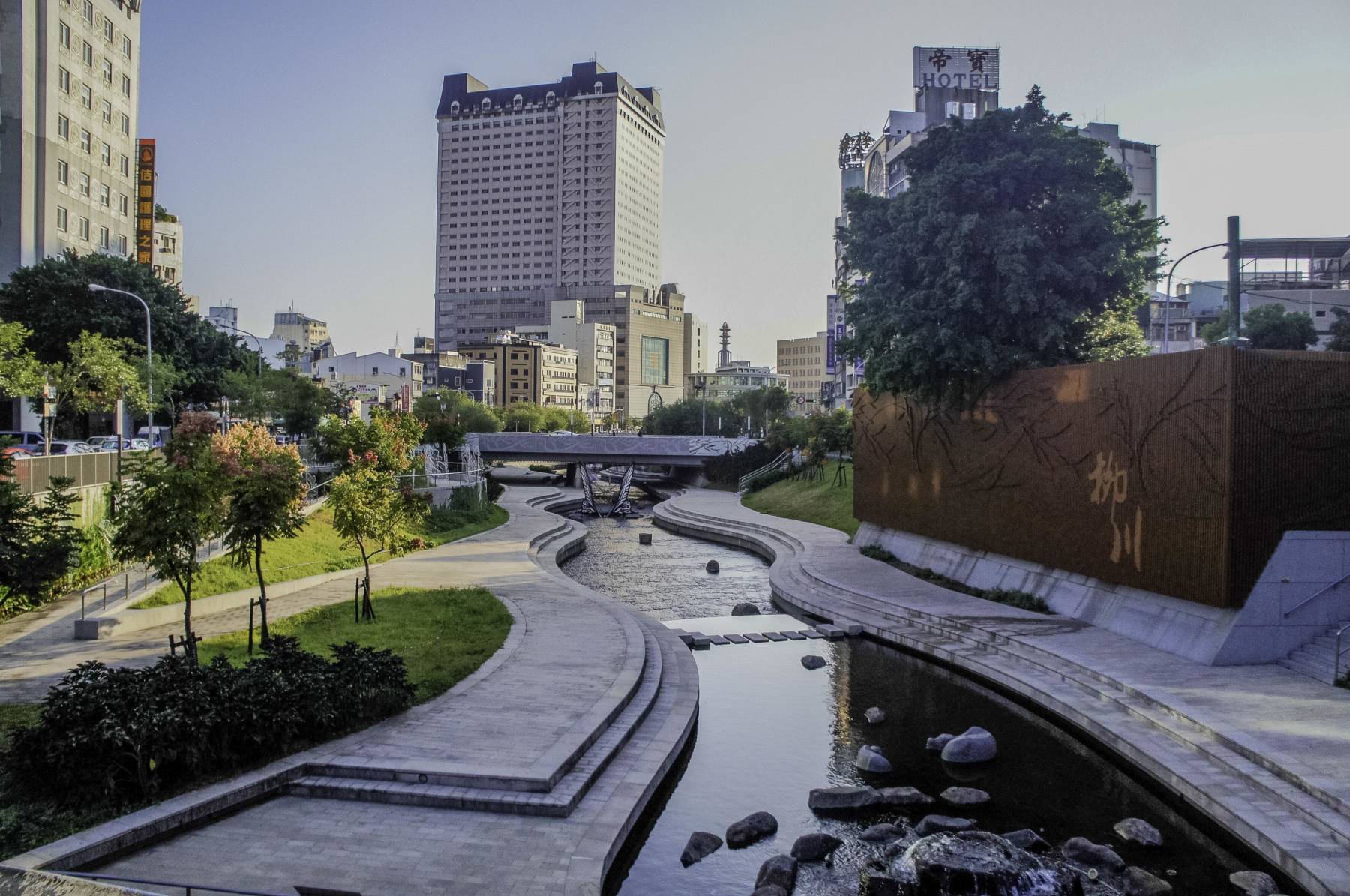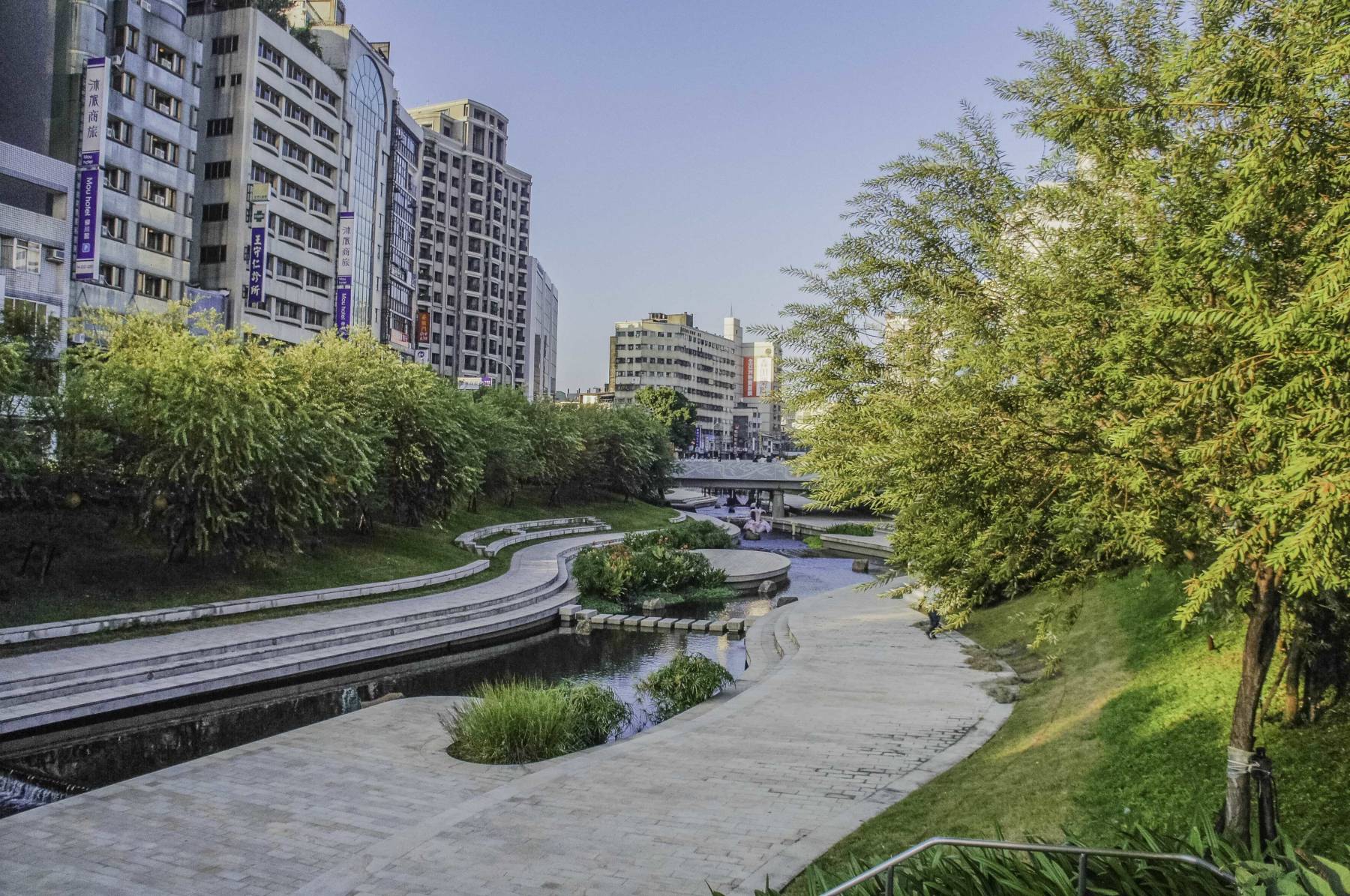In 2012 under a government-led project to revitalize the district, The Heart of Taichung City: Culture-led Urban Regeneration Plan, aimed to enhance connections between the old and new parts of the city centre through creating an attractive core. Enhancing the integration of blue and green infrastructure into the urban fabric is one of six avenues being pursued to deliver the objectives of the plan. “The management of the waterways determines a city’s destiny,” explains Taichung Water Resources Bureau Director Chou Ting-chang, “We wanted to restore the reputation of ‘Little Kyoto’ for the old downtown.”
With financial support from the Environment Protection Agency, Taichung City’s Water Resource Bureau designed a two-phase remediation and improvement project to give the Liuchuan canal back some of its lost glory. The initiative was designed to improve the canal’s water quality and flood-prevention capabilities, as well as to create a waterfront environment that would help make the old district more attractive.
Phase one of the project, undertaken in 2015, covered four kilometres of the canal. It first involved addressing water quality issues resulting from point source pollution between the Chongde Liu and Zhongzheng Liu bridges. The following year, immediately downstream between the Zhongzheng Liu and Min Quan Liu bridges, a 300-meter long new landscaped river scenery was complemented, which reconnected the old central district with its river while tackling local non-point source pollution from street runoffs.
Between the Chongde Liu and the Zhongzheng Liu bridges, 30 sewage interceptors were put in place to divert polluted water towards sewage treatment facilities prior to being released back into the waterways. Part of the sewage intercepted every day (about 10,000 tons) is treated at the newly built Zhonghua Water Purification Station located next to the canal, while the rest is taken to existing wastewater treatment plants. Overall this amounts to over 57,000 tons of sewage per day being diverted away from the canal for adequate treatment. The Zhonghua Water Purification Station was created as part of the Liuchuan canal remediation project beneath an existing parking lot. It relies on a gravel filtration system (gravel contact oxidation treatment). The below-ground facility features an observation corridor that is used to conduct educational tours and raise awareness about water quality and water treatment techniques.
Along the 300-meter landscaped stretch downstream of the Zhongzheng Liu bridge, the Water Resource Bureau emphasized the use of on-site natural features to further enhance water quality by reducing diffuse pollution from stormwater runoffs. The channel was widened by eight meters on each side by taking over highway space on each bank. The concrete embankments previously flanking the canal were replaced with gentle grass slope reinforced with geocell mats. 159 new trees were planted with a variety of native plants like Chinese fringe tree (Chionanthus retusus spp.), flamegold rain tree (Koelreuteria elegans spp.), Himalayan ash (Fraxinus griffithii spp.), sweetgum (Liquidambar styraciflua spp.) and tassel tree (Garrya elliptica spp.) as well as some native water willows (Salix mesnyi spp.). Some of the existing trees were incorporated to the new design, while 38 were relocated. A total of 3,083 square meters of new green space were created, allowing half of the riverbank to become water permeable.
A range of sustainable urban drainage techniques (also known as “low-impact development” stormwater management) were incorporated to the riparian landscapes thus created including raingardens, infiltration strips, bioswales and permeable paving. Underground rainwater storage tanks were incorporated along the riversides providing a sustainable water supply for landscape irrigation. Perforated drainpipes were laid under the river course to help adjust the amount of water during the high and low water level period.
This first phase of the Liuchuan canal remediation and improvement project has been hailed as a success in light of the wide range of benefits achieved. Water quality has significantly improved. In the upstream reach, between the Chongde Liu and Zhongzheng Liu bridges, the River Pollution Index (RPI) decreased from 7.25 to 3.5, meaning the water quality changed from “severely-polluted” to “lightly-polluted”. Within the 300-meter landscaped section, the RPI decreased from 8 (“severely-polluted”) to 3.75 (“moderately-polluted”). This is the result of the sewer interception and treatment process that was established upstream and of the sustainable drainage techniques that were implemented. Measurements have shown that these landscape-based solution to address diffuse pollution resulting from stormwater runoffs remove 69% of the suspended solids, 67% of the phosphorus and 24% of the nitrates that would otherwise enter the canal in this location. The Liuchuan canal no longer smells bad and its waters have become clear and clean enough to sustain fishes and damselflies, which are now routinely sighted by those who enjoy a stroll along the water edge.
The project has also withstood the test of flash flooding, with all plantings coping well while being submerged for short time periods. From a management point of view, reliance on an automated system to warn users of the Riverwalk of an impending flood has proven an effective approach to guarantee people’s safety at a fraction of the cost of relying on on-site staff.
Local residents and businesses have reported great satisfaction with the project. For residents, especially elderly people, the 300-meter landscaped reach provides an attractive destination for a peaceful walk or socialising within attractive scenery, offering plenty of opportunities to sit. Local businesses have reported increased footfall and consumer spending from locals and tourists alike. Local businesses surveyed by the Interior Ministry in 2017, a year after the completions of phase one of the project, reported a 50% increase in revenue compared to the previous year. The Spring Festival, also known as the Chinese New Year, saw a 26% increase in local business performance. The 300-meter landscaped section of the canal now features as the second most regarded attraction in Taichung’s Central District on the online travel platform Trip Advisor.
This success built public support and political confidence to proceed with a second phase of landscaped improvements along the Liuchuan canal and the implementation of a similar approach along one of Taichung’s other waterways, the Luchuan canal, also known as the Green River. Works along the Green River led to the creation of an award-winning 600-metre stretch of accessible soft landscape riverside inaugurated in 2018. The second phase of the Liuchuan canal remediation and improvement project is due for completion by the end of 2020. It stretches for seven kilometres downstream of the Min Quan Liu bridge and includes over two kilometres of landscaped riversides – the most extensive riparian edge restoration conducted so far. The project incorporates existing mature trees and features significantly less concrete than was used in phase one. A greater emphasis is placed on drawing connections to the local area, with the inclusion of outdoor classrooms in canal sections close to elementary schools and a mosaic display inspired by Lin Chih Chu’s work where the canal runs close to the memorial dedicated to the famous painter.
With this extensive roll out of “green and blue” approaches to river restorations, Taichung City is fast becoming a national leader in water sensitive urban design.



















